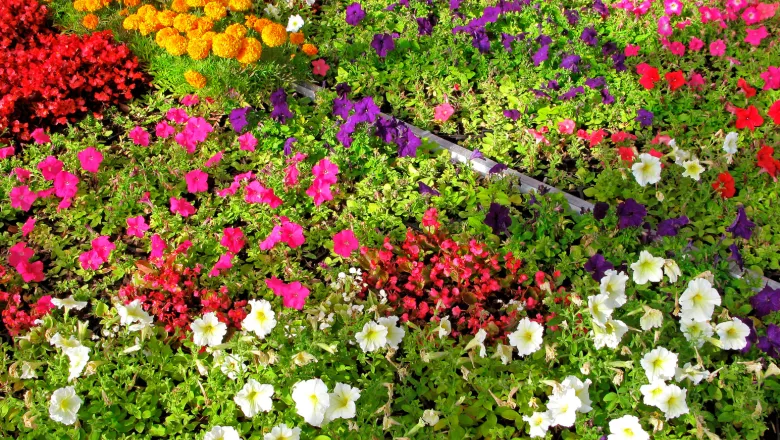Annuals, Perennials, and Biennials and How to use them in the Garden

Educator Resources
Many New Year's resolutions involve turning our thumbs a deeper shade of green and growing more of our own food. But if you’ve already dug into the newly arrived seed catalogs, you may have found a whole horticultural lingo is required for full comprehension.
Mastering the terms annual, biennial and perennial is one of the best places to start. These terms impact what can be planted, when it can be planted, and how long it will stick around.
What are Annuals?
Annuals are plants that can go through their entire life cycle in one season. They send out shoots and leaves, produce flowers, fruit and seeds, and then die back all within a year. Most garden vegetables and flowers are in this category, including tomatoes, peppers, squash, zinnias, and cosmos. These plants may also be called summer annuals; they start growing in the spring and die back in the fall. Annual also applies to winter annuals, or plants that start growing in the fall, continue through the winter then die back when the temperatures get too warm in the spring and early summer.
What are Perennials?
Perennials stick around for more than two years. After planting, perennials may not flower and fruit the first year because many require more than one year to complete their life cycle. Herbaceous perennials, or perennials without permanent woody stems will grow all season then die back to the roots in the fall. The following year, starting from the same roots, the plant will grow new shoots. These herbaceous perennials include many garden favorites like purple coneflower, black eyed susans and herbs like lavender and lemon balm.
Perennials also include fruit trees and shrubs like apples, peaches and blueberries, that contain permanent woody stems. These woody perennials continue year after year, elongating and sending out leaves from overwintering buds.
What are Biennials?
Biennials are in between. They need two years to go through their life cycle. Many biennials form a rosette of leaves right at the soil surface during the first growing season, then they return for a second year and send up shoots and flowers. Species in this category include foxgloves, and carrots. A carrot may form a suitable root for eating in year one, but a carrot won't flower and send out seeds until the second growing season, indeed making it a biennial.
Understanding the differences between these three types of plants seems simple. What complicates this system is that a species is classified as an annual or perennial depending on where it is growing. For example, a tomato will always be an annual in the mid-Atlantic region, but it grows as perennial in its native region of South and Central America. The United States Department of Agriculture (USDA) has developed a helpful system, known as the USDA Plant Hardiness Zone Map, to assist gardeners and farmers on selecting perennials for their locations. The map divides the country into zones determined by the extreme minimum temperatures, or the lowest temperature a region will experience. This map divides the United States into 13 zones, each with an “a” zone and a “b” zone. The coldest zone is Zone 1a which can be found far north in Alaska, and the warmest zone is 13b, found in Puerto Rico. The Mid-Atlantic Region has a range of hardiness zones from 5b to 8a depending on latitude, distance from the ocean and elevation, all of which have an impact on the minimum temperature. The current USDA Hardiness Zone map was recently updated in 2023, and it can be found at this link: https://planthardiness.ars.usda.gov/
For an example, on how to select plants based on hardiness zones, echinacea, or purple coneflower is a perennial in zones 4-9, so purple coneflower planted in zone 10 (the southern tip of Florida) may not behave as a perennial, in fact it may not even grow. This is all related to the climate adaptations of each individual species, and the region where it naturally grows. This goes hand in hand with the term “native plant.” Native plants are plants that have evolved naturally in a particular ecosystem.
The word tender is sometimes used to designate those perennials that need warmer winter temperatures, like some cultivars of rosemary. Gardeners can bring these plants indoors for the winter months then return them to their place in the garden when spring arrives. Like tender, hardy is sometimes used to designate perennials that are a sure bet to survive the winter. When thinking in terms of climate zones, hardy and tender are used to designate those plants that may be slightly out of the climate range of your region, plants that are adapted to slightly warmer or cooler climates than those of your garden but can be successfully grown with some extra care.
Use the hardiness zone for your region as a key for selecting the right plant for the right place. When a perennial species is listed in a seed catalog, that species' hardiness zone, or where it will behave as a perennial, will also be listed in the description. In addition to seed catalogs, the tags found on nursery plants will also list this information. Match your garden’s hardiness zone to the correct plant for best results.
Citations:
2023 USDA Plant Hardiness Zone Map | USDA Plant Hardiness Zone Map. planthardiness.ars.usda.gov.
Author:

Candace DeLong, WVU Extension ANR Agent
Candace.delong@mail.wvu.edu
304-822-5013